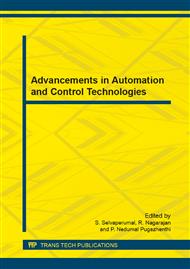[1]
N.G. Hingorani and L. Gyugyi, Understanding FACTS: Concepts and Technology of Flexible AC Transmission Systems. New York: IEEE Press, (2000).
Google Scholar
[2]
Y. H. Song and A. T. Johns, Flexible AC Transmission Systems-FACTS. London, U. K.: IEE Press, (1999).
Google Scholar
[3]
K.K. Sen and E.J. Stacey, UPFC-unified power flow controller : theory, Modelling and applications, IEEE Trans. Power Del., vol. 13, no. 4, pp.1953-1960, Oct. (1998).
DOI: 10.1109/61.714629
Google Scholar
[4]
A.F. Kerietal., UPFC-unified power flow controller: Modelling and analysis, IEEE Trans. Power Del., vol. 14, no. 2, pp.648-654, Apr. (1999).
DOI: 10.1109/61.754113
Google Scholar
[5]
S. Tara Kalyani, G. Tulasiram Das, Simulation of Real and Reactive Power Flow Control with UPFC connected to a Transmission line, Journal of theoretical and Applied InformationTechnology, (2008).
Google Scholar
[6]
Sukumar Mishra, Senior member, Neural – Network – Based Adaptive UPFC for improving Transient Stability performance of Power System, IEEE Trans. on Neural Networks, Vol. 17, no. 2, March (2006).
DOI: 10.1109/tnn.2006.871706
Google Scholar
[7]
P.K. Dash, S. Mishra, and G. Panda, Radial Basis Function Neural Network Controller for UPFC, IEEE Trans. on Power Systems, Vol. 15, No. 4, November (2000).
DOI: 10.1109/59.898104
Google Scholar
[8]
Xia Jiang, Joe H. Chow, Abdel-Aty Edris, Bruce Fardanesh and Edvina Uzunovic, Transfer Path Stability Enhancement by Voltage – Sourced Converter – Based FACTS Controllers, IEEE Trans. on Power Delivery, vol. 25, no. 2, April (2010).
DOI: 10.1109/tpwrd.2009.2034895
Google Scholar
[9]
Xuan Wei, Joe H. Chow, B. Fardanesh, Abdel-Aty Edris, A Dispatch Strategy for a Unified Power Flow Controller to Maximize Voltage-Stability- Limited Power Transfer, IEEE Trans. on Power Delivery, Vol. 20, No. 3, July (2005).
DOI: 10.1109/tpwrd.2005.848758
Google Scholar
[10]
Esmaeil Ghahremani and Innocent Kamwa, Optimal placement of Multiple- Type FACTS Devices to Maximize Power System Loadability Using a generic Graphical User Interface, IEEE Trans. on Power Systems, Vol. 28, No. 2, May (2013).
DOI: 10.1109/tpwrs.2012.2210253
Google Scholar
[11]
G. C. Ejebe, J. G. Waight, M. Santos-Nieto and W. F. Tinney, Fast Calculation of Linear Available Transfer Capability, IEEE Trans. on Power Systems, vol. 15, no. 3, Aug. 2000, pp.1112-1116.
DOI: 10.1109/59.871741
Google Scholar
[12]
Narasimha Rao. K, Amarnath. J and Kiran Kumar. K, Kamakshiah. S3, Available Transfer Capability Calculations Using Neural Networks in Deregulated Power, 2008 International Conference on Condition Monitoring and Diagnosis, Beijing, China, April 21-24, (2008).
DOI: 10.1109/cmd.2008.4580384
Google Scholar
[13]
Mohamed Shaaban, Yixin Ni, Felix F. Wu, Available Transfer Capability Evaluation by Decomposition, Vol. No. 0-7803-7173-9/01/$10. 00 © 2001 IEEE.
Google Scholar
[14]
Jitendra Kumar and Ashwani Kumar, ACPTDF for Multi-transactions and ATC Determination in Deregulated Markets, International Journal of Electrical and Computer Engineering (IJECE), Vol. 1, No. 1, September 2011, p.71~84, ISSN: 2088-8708.
DOI: 10.11591/ijece.v1i1.61
Google Scholar
[15]
Esmaeil Atashpaz-Gargari, Caro Lucas, Imperialist Competitive Algorithm: An Algorithm for Optimization Inspired by Imperialistic Competition.
DOI: 10.1109/cec.2007.4425083
Google Scholar


